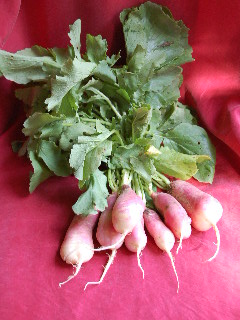
“Big things come in small packages!”
Whoever came up with that catchy little phrase might have been thinking about radishes.
These unassuming little garden goodies pack a real wallop when it comes to the health benefits we receive from the foods we eat.
First of all, radishes are high in Vitamin C, necessary in the body to rebuild tissue and blood vessels, and to help maintain healthy bones and teeth.
Vitamin C is also an important antioxidant vitamin, fighting those free radicals--thus fighting cellular damage that can lead to cancer and other diseases.
And, speaking of fighting cancer, studies have shown that the radish root or bulb (the part most commonly eaten) contains compounds that actually cause the death of cancer cells in the body. Now, that’s some big power from a small package!
Radishes are also a source of fiber and aid in helping prevent diabetes and heart disease.
Radishes also contain B vitamins and Vitamin K, in addition to potassium, manganese, magnesium, calcium, iron, copper, and zinc.
If you want to grow your own radishes in your home garden, it’s hard to imagine an easier plant to work with.
Plant in an area of full sun.
Radishes like the cool weather, so you can start them outdoors earlier than your regular “summer” plants like tomato and squash. Plan to plant in the late winter/very early spring (about 4 to 6 weeks BEFORE the last anticipated frost in your area).
Sow your radish seeds about an inch deep and an inch apart in rows about one to two feet apart. As they germinate and begin to grow, thin your plants to a spacing of at least 2 inches apart.
The radishes will grow rapidly and be ready for pulling and eating in just a few short weeks. Brush back a little bit of soil from the top of the ground just over the bulbs to check on their size, and don’t be afraid to start consuming them right away--the little ones and medium ones are often milder tasting (less hot and bitter) than the ones that get too large.
If you’re getting a bigger crop than you can consume before the radishes reach a large size, pull them, cut off the tops, and store your excess radishes in the refrigerator--or share some with your neighbors!
Then, plant another crop in the fall as the summer season ends. Remember--radishes are so cool they even like to grow in cool weather!!
 “Big things come in small packages!”
“Big things come in small packages!”